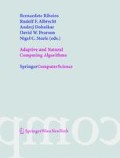Abstract
We propose replacing the traditional tree depth limit in Genetic Programming by a single limit on the amount of resources available to the whole population, where resources are the tree nodes. The resource-limited technique removes the disadvantages of using depth limits at the individual level, while introducing automatic population resizing, a natural side-effect of using an approach at the population level. The results show that the replacement of individual depth limits by a population resource limit can be done without impairing performance, thus validating this first and important step towards a new approach to improving the efficiency of GP.
Access this chapter
Tax calculation will be finalised at checkout
Purchases are for personal use only
Preview
Unable to display preview. Download preview PDF.
References
Banzhaf, W., Nordin, P., Keller, R. E., Francone, F. D. (1998). Genetic Programming-An Introduction. Morgan Kaufmann, San Francisco, CA.
Koza, J. R. (1992). Genetic programming-on the programming of computers by means of natural selection. The MIT Press, Cambridge, MA.
Soule, T., Foster, J. A. (1999). Effects of code growth and parsimony pressure on populations in genetic programming. Evolutionary Computation 6(4):293–309
Poli, R. (2003). A simple but theoretically-motivated method to control bloat in genetic programming. In Ryan, C. et al. (eds.), Proceedings of EuroGP-2003. Springer, Berlin, pp. 204–217
Luke, S., Panait, L. (2002). Lexicographic parsimony pressure. In Langdon, W. B. et al. (eds.), Proceedings of GECCO-2002. Morgan Kaufmann, San Francisco, CA, pp. 829–836
Panait, L., Luke, S. (2004). Alternative bloat control methods. In Deb, K. et al. (eds.), Proceedings of GECCO-2004. Springer, Berlin, pp. 630–641
Wagner, N., Michalewicz, Z. (2001). Genetic programming with efficient population control for financial time series prediction. In Goodman, E. D. (ed.), GECCO-2001 LBP, pp. 458–462
Kennedy, C. J., Giraud-Carrier, C. (1999). A Depth Controlling Strategy for Strongly Typed Evolutionary Programming. In Banzhaf, W. et al. (eds.), Proceedings of GECCO-1999. Morgan Kaufman, San Francisco, CA, pp. 1–6
Langdon, W. B. (2000). Size fair and homologous tree crossovers for tree genetic programming. Genetic Programming and Evolvable Machines 1:95–119
Silva, S., Almeida, J. S. (2003). Dynamic maximum tree depth. In Cantú-Paz, E. et al. (eds.), Proceedings of GECCO-2003. Springer, Berlin, pp. 1776–1787
Silva, S., Costa, E. (2004). Dynamic limits for bloat control. In Deb, K. et al. (eds.), Proceedings of GECCO-2004. Springer, Berlin, pp. 666–677
Luke, S., Balan, G. C., Panait, L. (2003). Population implosion in genetic programming. In Cantú-Paz, E. et al. (eds.), Proceedings of GECCO-2003. Springer, Berlin, pp. 1729–1739
Fernandez, F., Vanneschi, L., Tomassini, M. (2003). The effect of plagues in genetic programming: A study of variable-size populations. In Ryan, C. et al. (eds.), Proceedings of EuroGP-2003. Springer, Berlin, pp. 317–326
Fernandez, F., Tomassini, M., Vanneschi, L. (2003). Saving computational effort in genetic programming by means of plagues. In Sarker, R. et al. (eds.), Proceedings of CEC-2003. IEEE Press, Piscataway, NJ, pp. 2042–2049
Tomassini, M., Vanneschi, L., Cuendet, J., Fernandez, F. (2004). A new technique for dynamic size populations in genetic programming. In Proceedings of CEC-2004. IEEE Press, Piscataway, NJ, pp. 486–493
Silva, S. (2004). GPLAB-a genetic programming toolbox for MATLAB. http://gplab.sourceforge.net
Author information
Authors and Affiliations
Editor information
Editors and Affiliations
Rights and permissions
Copyright information
© 2005 Springer-Verlag/Wien
About this paper
Cite this paper
Silva, S., Silva, P.J., Costa, E. (2005). Resource-Limited Genetic Programming: Replacing Tree Depth Limits. In: Ribeiro, B., Albrecht, R.F., Dobnikar, A., Pearson, D.W., Steele, N.C. (eds) Adaptive and Natural Computing Algorithms. Springer, Vienna. https://doi.org/10.1007/3-211-27389-1_58
Download citation
DOI: https://doi.org/10.1007/3-211-27389-1_58
Publisher Name: Springer, Vienna
Print ISBN: 978-3-211-24934-5
Online ISBN: 978-3-211-27389-0
eBook Packages: Computer ScienceComputer Science (R0)

